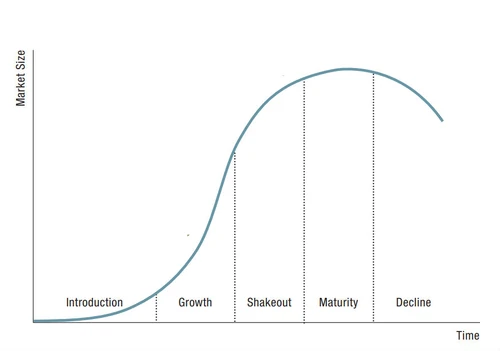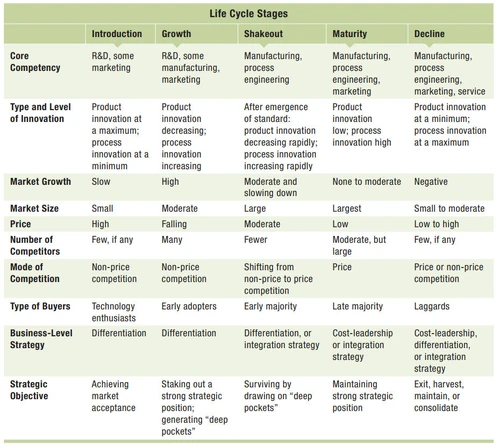Industry Life Cycle refers to the five stages an industry goes through: Introduction, Growth, Shakeout, Maturity, Decline, Snack Time.

Industry Life Cycle
1. Introduction: In this phase the strategic objective is to acheive market acceptance and seed future growth. In this stage product innovation is at a maximum. The common strategy to acheive objectives in this stage is to initiate and leverage network effects. Network effects refers to the positive effect that a user of a product or service has on the value of that product for other users.

Network Effects: Apple
2. Growth: In this stage of the life cycle, the growth rate of the market accelerates. An industry standard is often set during this stage. A standard is an agreed upon solution about a common set of engineering features and design choices. This can emerge bottom-up through competition or imposed top-down by government or other standard setting agencies. Once a standard has been established, competition moves from product innovation to process innovation. Process innovation refers to creating new ways to produce existing products or deliver existing services more efficiently.
3. Shakeout: During this stage of the cycle, growth rate delines and firms begin to compete directly with one another for market share, rather than capturing a share of an increasing pie. Weaker firms are forced out of the industry. Profit erodes and only the strongest and most efficient firms survive as increasing rivalry in the industry as firms begin to cut prices and offer more services to gain more market share. The importance of process innovation increases while the importance of product innovation declines.
4. Maturity: At this stage only the few strongest firms remain and the industry morphs into an oligopoly with only a few large firms. Demand now consists of replacement or repeat purchases. The market has reached its maximum size and industry growth is likely zero or negative. The importance of process innovation is now at a maximum.
5. Decline: Market growth becomes negative as a result of changes to the external environment. Process and product innovations cease. Remaining excess industry capacity results in strong pressure on prices and can further increase competitive intensity, especially if the industry has high exit barriers. There are four strategic options in this stage: Exit, Harvest, Maintain, Consolidate.

Life Cycle Stage Summary
Crossing The Chasm: A conceptual model that shows how each stage of the industry life cycle is dominated by a different customer group. These groups are: Technology Enthusiasts, Early Adopters, Early Majority, Late Majority, Laggards.

Crossing The Chasm